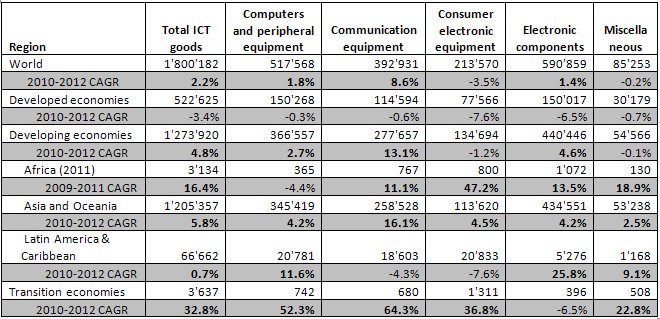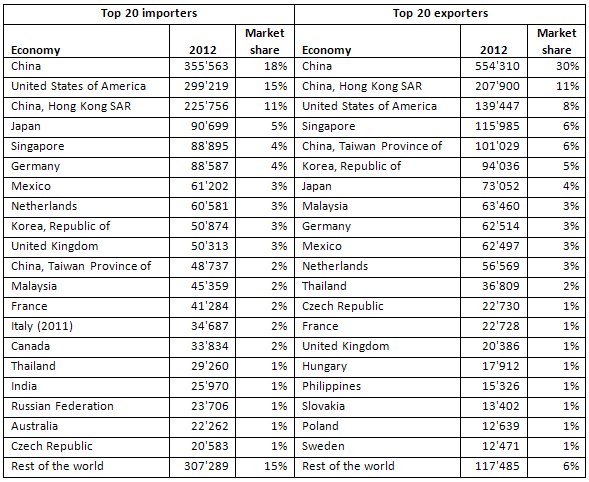The mobile telephone revolution in developing countries continues to drive global trade in information and communication technology goods, with China pre-eminent as the world's top trader in all categories of the sector.
World imports of information and communication technology (ICT) goods stood at almost $2 trillion in 2012, according to the latest data released by UNCTAD, up from $1.8 trillion in 2011.
This puts ICT goods such as mobile phones, smartphones, laptops, tablets, integrated circuits and other components at 11 per cent of world merchandise trade and among the top products traded globally - exceeding trade in agricultural products (9.2 per cent) and motor vehicles (7.2 per cent) according to World Trade Organization data.
The latest figures also show that developing countries continued to receive more than half of total ICT goods imports at 54 per cent. Between 2010 and 2012, most of the growth in ICT goods trade was spurred by rising demand for communication equipment, particularly in developing economies (Table 1).
Telephones for cellular networks remained the second most traded ICT item worldwide after integrated circuits, with a global value of $190 billion, or just under 10 per cent of total imports of ICT goods. In some regions, however, communication equipment accounted for a much greater share - in Africa it stood at 43 per cent in 2011.
In developed economies meanwhile, communication equipment was the only ICT category with positive growth, at 7 per cent between 2010 and 2012. During the same period, computer and peripheral equipment imports grew significantly in developing and transition economies, at 4 per cent and 11 per cent respectively, but stagnated in developed economies (Table 1).
In 2012, global imports of notebooks, tablet PCs and other portable data processing devices were valued at $141 billion.
The latest UNCTAD figures, which add 2012 numbers to a dataset that has been compiled since 2000, identify developing economies as a significant part of ICT value chains (Chart 1).
The data show that China stands out in many ways in the ICT landscape (table 3). In 2012, ICT goods made up as much as 27 per cent of China's total merchandise exports (chart 1) and China remained the world's top exporter of all main categories of ICT goods. China is also the top importer of ICT goods, accounting for 18 per cent of world imports and 34 per cent of all electronic component imports, including re-imports from Hong Kong (China).
Asian developing economies represented the leading production hub of ICT goods, accounting for two thirds of world exports. Economies in East and South East Asia remain among the only net exporters of ICT goods, together with five European countries - Czech Republic, Hungary, Ireland, Malta and Slovakia - and Israel (Chart 1).
Apart from these, all other developing and transition economies represented a very modest share of global ICT goods trade, with 4 per cent of total exports and about 8.5 per cent of total imports. As net importers, these economies benefited from price reductions and the rapid pace of technical improvements in ICT goods.
Between 2010 and 2012, computer and peripheral equipment imports caught up in value terms with communications equipment imports in all developing regions except Africa, where communication equipment imports remained more important (Table 2).
Mexico is the only Latin American country featuring among the top 20 exporters. In 2012, its exports of ICT goods reached $62 billion, mainly to the United States market. Costa Rica was the second largest exporter ($2.2 billion) in the region followed by Brazil ($1.3 billion).
ICT goods from Africa account for less than 1 per cent of the continent's total merchandise exports, with a total value of about $3 billion, because few African countries have developed an ICT goods manufacturing industry.
Notable exceptions include Morocco's exports of electronic components ($565 million) mainly to Singapore, Italy and France; Tunisia's exports of consumer electronics ($631 million, 2011) and communication equipment ($390 million, 2011) to France; and Uganda's exports of mobile phones ($149 million) to the United Arab Emirates.
Table 1. ICT goods imports by region and product group, 2012 (million USD)  Source: UNCTADStat. |
Table 2. ICT goods exports by region and product group, 2012 (million USD)  Source: UNCTADStat. Note: Differences between exports and imports are due to several factors such as imports are recorded cif (cost insurance and freight) while exports are fob (free on board), recording under different categories and other data quality issues. Imports are usually recorded more accurately as they generate tariff revenues. CAGR: Compound annual growth rate. |
Chart 1. Proportion of ICT goods exports and imports in total merchandise trade, 2012  Source: UNCTADStat. Note: Size of bubbles: ICT goods exports in 2012. Included are 44 economies representing 99% of global ICT goods exports. The values for Hong Kong (China) are much higher than for the other economies, at 42% for ICT3 and 41% for ICT4. |
Table 3. Top 20 importers and exporters of ICT goods in 2012 (million USD)  Source: UNCTADStat. |



